Monday 22 March 2010
Friday 19 March 2010
Evaluation draft deadline mon 22nd 9am, final deadline mon 29th 9am
PowerPoint uploaded to moodle
1. In what ways does your media product use, develop or challenge conventions of real media products?
What conventions of professional products have you used in your own film? (narrative conventions, character conventions, genre, camerawork, sound, editing, special effects, mise-en-scene? Use screen grabs of your own sequence to illustrate each example where you have followed conventions or gone against (challenged) conventions. Also use images from the films that have influenced you where relevant.
2. How does your media product represent particular social groups? (gender, age, ethnicity etc.)
Compare a character in your sequence to a character in a professional film (use images). If you have included a villain/victim character, does the character follow conventions of characters in professional films. For example, is your villain male? Is your victim female? Therefore how are you representing gender?
3. What kind of media institution would distribute your media product?
Discuss similar professional films and their production companies (use images of the films and logos). Which production Company do you think would distribute your film? (if it was professional and if you had made the full film).
4. Who would be the audience for your media product? (BBFC and target audience) Use images from a similar product with a similar target audience. Remember that target audience is not the same as classification.
5. How did you attract/address your audience?
Refer to Significant moments in your sequence where you have tried to generate a response from the spectator (a close up to encourage identification with a character, music that encourages the spectator to feel suspense, tense, visceral reaction etc.) What techniques have you used to encourage the spectator to want to see the rest of the film? (Clues about narrative, character, etc.) Use screen grabs of your own sequence.
6. What have you learnt about the technologies from the process of constructing your product?
(blog, camera equipment, editing software – Final Cut Express, istopmotion, Garageband etc.) Use screen grabs/photos of all these things. Be very specific about tools/effects/techniques learnt not just ‘I have learnt a lot about the software’
7. Looking back at your preliminary task, what do you feel you have learnt in the progression from it to your final product?
Discuss your second preliminary task that you did in a week before starting Thriller. Discuss what you have learnt since then about construction of micro elements in order to create meaning, how to use different techniques, practical skills etc. How have you built on your knowledge that you learnt from the prelim task? Use screen grabs of your prelim task and your sequence where relevant.
Thursday 18 March 2010
Music for torture scene
Because the our original music may not be long enough to last the whole of our sequence as intended, I have created a short piece that could be used in the torture scene if our first choice does not last for the required length of time. The song was created using Acoustica Mixcraft.
The song begins with light static and a rumbling noise. These sounds represent the victims disorientation and confusion. They may be played whilst no images are showing to truly show the victims perspective, as he cannot see due to the bag over his head. A heartbeat then begins, which gradually grows louder over the course of the song. I had originally planned the heartbeat to be representative of the victims, but I could not find a loop that gradually sped up which still sounded like a human heartbeat. Therefore the heartbeat is more representative of the killers - the steady beat represents his control of the situation, and his lack of fear. The heartbeat also adds to the atmosphere of the scene - the heart is integral to human survival, and when it stops beating we die. Therefore hearing the heart beat so loudly suggests that somebody's heart will stop beating soon, and this creates tension. The main sound within the composition is the eerie noise present throughout the middle of the song. This again adds to the atmosphere, and helps create a sense of fear within the viewer. I have let the heartbeat go on for a long time after the other aspects of the song fade out as it can easily be stopped at any point, whilst allowing time for the title shot to appear if necessary.
Below is a screenshot of Mixcraft showing the construction of the song, and the various loops that were used.
Title Shot
This is an image we may use as the title shot during our opening sequence. It will feature at the end of the film and reveal the name of the film to the audience. It contains many links to our sequence and the rest of the movie, which I will explain.
The most obvious and striking feature of the image is the blood splattered across the pages of a newspaper. This connotes the themes of murder within our film and works in conjunction with the headline of the newspaper the achieve this. The full headlines reads: 'Killer strikes again: Another body found'. This, as with the blood, supplements the theme of murder and death. However, it can also be related to the case our detective is solving. Much of the headline is obscured by blood splatters, and even more importantly, nearly all of the text is covered with blood. This directly relates the to mystery - although our detective knows what is going on, he knows not why or how. The paper represents this - the title is just visible, but the details within the article cannot be seen.
The title of the film, Ascent, refers to the killers ascent to power, and how he becomes a more accomplished killer as the film wears on. On the other hand, our detective's condition worsens as the film progresses, and he fails to make any significant breaks on the case. This contrast between antagonist and protagonist is mirrored in the Ascent text -the light is close to the dark, but has not broken through.
Below are some images showing the creation of the image on Photoshop:
 Overview of Photoshop and the image
Overview of Photoshop and the image
Wednesday 17 March 2010
Peer Review Feedback
Thank you for the feedback. The main issues people found with our sequence were:
- The length of the kill scene. Many of our peers found it to be too long and this took away some of the shock value. By shortening it and making it 'short and sharp' we can increase the impact of the shots. This is extremely useful feedback for us as these shots are amongst the most important in our sequence. By increasing the effectiveness of these shots we will improve our sequence as a whole.
- The lack of a soundtrack/other audio effects. This is not a big issue as Sam has already created music to accompany the footage, but we had not uploaded it in time for the rough cut. However, it may need to be made longer to make it last for the desired amount of time. In response to the feedback, we may also add various diagetic sounds to our sequence. For example, a police siren in the background whilst the victim is walking to suggest danger.
- Relevance of newspaper articles. This is not a major issue as we will only be flashing up the images of the newspaper for a split second once we have finished editing. As we had kept some raw footage aside at the end of the sequence for future editing the newspaper articles were legible. Once we have finished editing they will not be clear, and only cast the impression of an article. However, this feedback is still useful, as we now know that we cannot show newspaper articles for longer than half a second.
- Not understanding much of the footage. This is probably due to the fact we have not finished editing yet. Only the first minute of footage was in its final order and edited. The last 3/4 minutes was compromised of raw, unedited, unordered footage which will not feature in the final cut.
Our peers did like:
- Our range of camera shots and angles. People thought that these added to the atmosphere and made the sequence more enjoyable to watch. This is useful feedback as we had been considering refilming certain shots. However, because of this feedback we no longer feel this to be necessary.
- Acting during the first 2-3 minutes.
Friday 12 March 2010
response to feedback
First of all we agree that our killing scene needs to be more quick paced to create suspense and disagree with the point about of not making a soundtrack, we just haven't added it yet.
improvements we need to make is more editing as it clearly stated. this will in turn make the sequence shorter as its too long. We may also take out certain scenes that was said to have no relevance to the narrative. Our soundtrack will also be added causing it to be more suspenseful to the audience.
It is important to get feedback as it gives us a view on if we're reached out to our target audience, having the views and opinions on others will allow us to make changes to the sequence to make it even more suspenseful.
Rough Cut feedback
We really didn't get it. Some of the sequences did not make any sense. No soundtrack. There were parts with no noise at all. Good acting through-out the first 2-3 minutes. The killing sequence was too long an was unrealistic. Good camera work (angles/close-ups).
S2-54
The editing at the start is too quick. But very good angles and close ups. For the kill part of it it could be a fast edit. We think that the kill sequence is realistic if you could edit it fast it would look better. You probably haven't started a soundtrack but it does need one.
S2-49:
We think we that you have got some really good shots from the footage we have seen , especially in the torture/killing scene. You should include a sound track for the sequence, because you have no dialogue and this would help to build tension also. You could include diegetic sound as well for parts such as when the man has the bag over his head and is trying to get out. Maybe you should try and create more mystery.
We think that it would be good with more editing.
S2-50:
We think that the killing scene should be short and sharp to create more suspence. There are some very good and effective shots. Particularly, the shots of the feet, both when walking and when the character is being attacked. The newspaper clippings are not all relevent to the rest of the sequence, for example there is a shot of a frontpage which doesnt link in with the sequence.
S2-51 Feedback:
First 30 seconds well done, a nice selection of shots. During editing i would like to see some nice short shorts to create tension.When making q soundtrack make sure that it builds up and is conitusly adding to the atmosphere.
Tuesday 9 March 2010
Rough Cut
As we have only just begun to edit our sequence is still largely made up of raw footage. Only the first 30 seconds are edited. The rest of the footasge is only a rough guess as to what it may look like.
Final editing for draft 9/03/10
We are also going to cut our longer scenes as we have around 10 minutes of footage we can use. This will allow us to edit certain scenes giving our thriller the best effects with shot types, this will make the audience feel a lot more suspense while watching the sequence.
Monday 8 March 2010
First attempt of first scene
Lesson plan 08/03/10
Tuesday 23 February 2010
Evulation Questions
2) How does your media product represent particular social groups?
3) What kind of media institutes might distribute your media product and why?
4)who would be the audience for your media product
5) How did you attract or address your audience?
6) What have you learnt about technologies from the process of constructing this product
7)Looking back at your preliminary task, what do you feel you have learnt in the progression from it ti the final product?
Certificate
The organisation in charge of awarding films in the UK their respective certificates is the British Board Of Film Classification. (BBFC) We have decided that our film should be classed as a 15. The official definition of a 15 from the BBFC;
"Certificate 15 is suitable only for 15 years and older. No one younger than 15 may see a '15' film in a cinema. No one younger than 15 may rent or buy a '15' rated video"
http://en.wikipedia.org/wiki/Motion_picture_rating_system#United_Kingdom
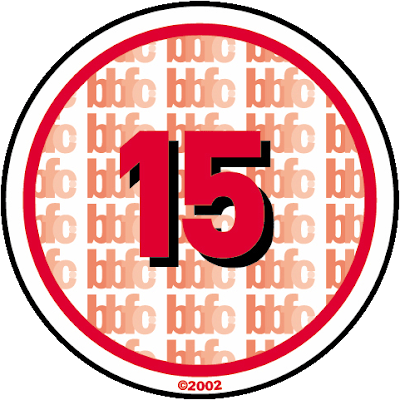
We have decided our film is best suited to a 15 certificate. We have reached this decision after examining each of the factors below: the official guidelines for a 15 rated movie.
Discrimination
The work as a whole must not endorse discriminatory language or behaviour.
Our film does not contain any discrimination. Although all our victims are gay, this is not portrayed in any way via discrimination.
Drugs
Drug taking may be shown but the film as a whole must not promote or encourage drug misuse. The misuse of easily accessible and highly dangerous substances (for example, aerosols or solvents) is unlikely to be acceptable.
Although drugs are allowed to be shown in a 15, our film will not feature drugs in any way.
Horror
Strong threat and menace are permitted unless sadistic or sexualised.
Our film does contain horror in the case of the abduction and murder, but it is neither sadistic nor sexualised. No torture or sexual assault will be pictures graphically.
Imitable behaviour
Dangerous behaviour (for example, hanging, suicide and self-harming) should not dwell on detail which could be copied. Easily accessible weapons should not be glamorised.
The abductor within our sequence will use a knife as one of his weapons. To make the film suitable for the 15 certificate we will not focus or glorify the armanent. No dangerous behaviour will be featured.
Language
There may be frequent use of strong language (for example, ‘fuck’). The strongest terms (for example, ‘cunt’) may be acceptable if justified by the context. Aggressive or repeated use of the strongest language is unlikely to be acceptable.
There will be some minor language in our sequence, but it is neither strong nor frequent, thus making our film suitable for a 15 rating in the language aspect.
Nudity
Nudity may be allowed in a sexual context but without strong detail. There are no constraints on nudity in a non-sexual or educational context.
No nudity will feature.
Sex
Sexual activity may be portrayed without strong detail. There may be strong verbal references to sexual behaviour, but the strongest references are unlikely to be acceptable unless justified by context. Works whose primary purpose is sexual arousal or stimulation are unlikely to be acceptable.
There will not be a sex scene in our sequence, nor the film as a whole.
Theme
No theme is prohibited, provided the treatment is appropriate for 15 year olds.
As no themes are prohibited, our film would be suitable whatever the theme.
Violence
Violence may be strong but should not dwell on the infliction of pain or injury. The strongest gory images are unlikely to be acceptable. Strong sadistic or sexualised violence is also unlikely to be acceptable. There may be detailed verbal references to sexual violence but any portrayal of sexual violence must be discreet and have a strong contextual justification.
Though our film contains some violence, it is not particularly strong, not focused upon and is neither sadistic or sexualised. No verbal references are made to sexual violence nor is any sexual violence portrayed.
Monday 22 February 2010
Here are some screenshots of the program i used to make this music, and the song in progress.


What i tried to aim in achieve in this song is to create an suspenseful atmosphere. i think that the bellowing saw sounding bass line adds to the life and the energy and mystery to the music.
The way I achieved making this soundtrack was made from different types of effects with complex number of layers. Playing with the pattern volume helps lifts the bass up and down and give it the song a dip and rise in the volume. This will make the audiance feel more involved with the music and also would give of a vibe of energy and excitement to the audience creating a suspenseful atmosphere.
Most people under the age of 15 would have trouble following our sequence due to the complex themes of morality and murder. The non-linear ordering may also confuse a younger audience. Because of this, our film will not be suitable to most people under 15.
Our film will feature a lot of modern aspects. For example, the music for much of the sequence will be Dubstep, a genre popular with young people. In addition to this the detective and victims will all be fairly young - this will allow our target audience to empathise with them. Because of these features we believe our film is best suited to people aged 15-30. Older people may struggle to understand aspects of the sequence and find it harder to empathise with the characters.

Tuesday 9 February 2010
The first shot of the detective will be of him leaning over a desk illuminated by a lamp . Much of the room will be in darkness. This will be representative of the detective and how most of the mystery is unclear to him. As the detective pores over the cluttered desk, images of newspaper articles related to murder will briefly appear, amongst other objects. As the sequence progresses the detectives expression will change from despair to thoughtful to excitement. As he has a revelation about the murders he will slam on the lights, fully illuminating the room. This represents the fact the detective has had an idea that may solve the murders. He rushes over to a board filled with newspaper cuttings and stares at it. The shot changes to a close-up of his eye and in it a map is reflected.
This sequence is intertwined with the abduction sequence, so the sequence is presented in a non-linear way.
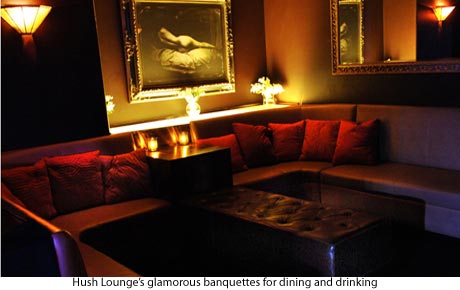
Example of the kind of lighting we are aiming for.
The victim is walking down a street. He eventually arrives at an alleyway, and looks over his shoulder. This will betray his feelings of nervousness. A low shot will show him walking down an alleyway. As he gets closer an ominous dark shape will move across the camera, out of focus. This will greatly heighten the tension within the scene - what/who is the shape? Numerous close-ups from various angles will show the attacker shoving a bag over the abductees head, and the screen will fade to black. We have decided to use close-ups as they will keep the attackers identity hidden and create a sense of confusion within the viewer. These shots have been inspired by the strangulation sequence in No Country For Old Men, where numerous shots from different angles chronicle the killing. (Although in this case the victim is not killed.)
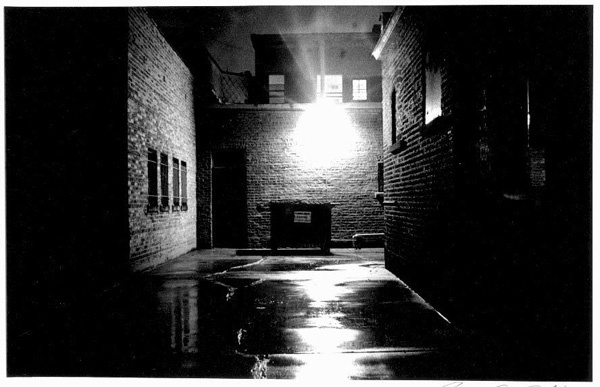
An alleyway similar to what we will use.
Monday 8 February 2010
Still Shots of Shot List and Story Board
Costumes
Our detective will cast the appearance of a clean, neat man who has recently been neglecting his appearance. For example, he wears his top two shirt buttons undone and has his tie loose. His trousers are creased and shoes dirty. All of this will connote the fact that the man is under stress, and doesn't have time to properly care for his appearance. The costume is similar to Brad Pitt's character in Se7en - a young detective whose appearance is unkempt.
White shirt - representing good/justice.
Black Trousers - darker side of personality. (Two sides shown by split between Trousers/Shirt)
Skinny Black Tie - suggests formal business.
Black/Brown shoes - suggests smart dressing.

Brad Pitt (left) in Se7en.
The victim will not be wearing any particular items of clothing - his apparel will be simple. This appearance of normality will cause the viewer to ask questions of why he is attacked - is he as normal as he seems?
- Shirt/Jacket.
- Jeans.
- Trainers.
Abductor/Attacker
All clothing worn by the attacker is dark to connote his lack of morality. A balaclava will cover his face to represent the hidden side of his personality - the murderer within. A similar technique is used in the Dexter opening sequence, where his face is never fully shown whilst murder related shots are being shown.
- Black shirt. (Formal?)
- Black jeans.
- Black shoes with white soles - this connotes that the killer is not completely consumed by evil.
- Balaclava.
Friday 5 February 2010
Dexter Opening Credits Analysis
The sequence then begins to focus on the cutting up/disposing of the victims. This is effectively displayed in numerous ways, all linked to food. For example, a piece of pork is dissected, and egg is sliced, mixing with ketchup (Connoting blood) as it separates. A highly effective shot of an orange being sliced in two against a red background again connotes the dissecting of victims bodies, with the red again suggesting a presence of blood. The orange half is then squashed and comes apart with a 'squelch'. All of these shots are representative of the dissection of the bodies, providing vivid imagery which creates apprehension from a seemingly innocent activity.
Next images of flossing and laces being tied are shown. The taut string/ropes constrict the flow of blood, which represents Dexter being restricted - unable to reveal his true identity, which leaves him feeling trapped. He is then shown pulling a shirt over his head, slowly bringing his face into view for the first time. This connotes the hidden side of Dexter - throughout the imagery which represents his killings his face is never shown - this aspect of his personality is not known to others. The brief shot of Dexter locking the door infers that this part of his life is kept apart from the rest of the world. This knowledge helps the viewer emphasise with Dexter.
Shots are almost exclusively close-up. This not only makes the everyday activities seem more sinister, but also keeps the identity of Dexter hidden. The close-ups tend to focus on things related to death - the knife slicing the orange, the floss restricting blood flow and the blood splattering onto the sink etc.
Sound also plays an important role in creating the atmosphere - it contributes greatly to the sinister atmosphere within the sequence. The ominous horns kick in at significant moments, emphasising their importance. Sound effects are also key - they add more emphasis to moments such as the crushing of the orange.
Monday 1 February 2010
Plot of Thriller
Planning for filming
- Victim - Normal clothing to suggest that he is only a citizen.
- Attacker - Dark clothing to represent evil within character.
- Detective - Suit. Messy to suggest he is a relatively new detective. (Shirt with buttons undone/skinny tie loose)
Props
- Attackers weapon - plastic bag. Replica fake gun.
- Newspaper articles created on Photoshop.
Lighting
- Detective's desk lit by lamplight.
- Streets/alley where attack takes place in daylight.
Make-up/hair
- We don't plan to use much make-up, although some may be used to give the image of bruising around the victims neck.
- Mess up/Ruffle up the victims hair.
List of equipment
- Camera/Tripod.
- Character clothing.
- Newspaper articles.
- Attackers weapon. (Bag/Knife)
- Cup of tea.
Times and dates of filming
Location
'Office area' - Media classroom/office.
Alleyway in Cambridge
Actors
'Victim' - Dave
'Villan' - Dave
'Detective' - Sam
Production roles
Director - Dave Haynes
Producer - Kriss O
]Kai-Koi
Sound - Sam Bols
Editing - Dave O'Keefe
Test photos/footage
Friday 29 January 2010
Ideas from various films.
- A decrease in the duration of shots as the scene progresses. This increases the pace of events, and creates a sense if apprehension within the viewer.
- We also noticed that clothing can play an important part when introducing characters. For example, a man in a suit will seem less relaxed than a man in shirt and jeans.

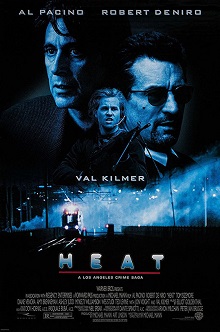
No Country For Old Men
- Heavy, dramatic music is excellent at creating a cinematic atmosphere, which helps to draw the viewer into the film.
- A variation of shots depicting a single event. For example, in this film when the Policeman is being strangled there are numerous shots showing different angles.
- Filming the same scene numerous times can makes editing easier, and give more options to the people editing.
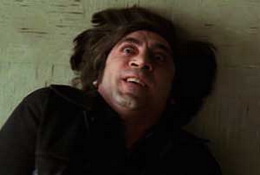
- Soundtrack again plays an important role - the subtleness of the music can greatly affect the impression given to the viewer. When we create our sequence high pitched sounds may be more effective at creating suspense.

Tuesday 26 January 2010
Feedback for idea
One of the main problems with our idea that was pointed out by the group was how we could get a crowd for our abductee and his pursuer to run through. It was suggested that we could ask people in town to help us, but this is unlikely, so a crowd will probably have to be avoided. The chase scene is also unlikely to fit within 2 minutes without dominating the sequence. Another problem raised was how we would light the garage so it is suitable to film in. This could be sorted by using torches or lamps. (Media department lighting cannot be used as it may not be taken off premises.
However, people reacted positively to the idea of the garage and the sounds/effects we could use from it such as the doors closing suddenly. It was also agreed that a dark room would suit the location best, so we are going to try and create a gloomy atmosphere within the room we use.
Monday 25 January 2010
Micro and Macro elements within our film
Characters - two main characters: abductor and abductee.
Narrative - Man walking around busy location. Crowds thin out. Turns corner and is hit in face with a bat. Blacks out. Wakes tied to chair in dark location. Speaks briefly with abductor. Abductor unmasks himself - man says 'It's you!'.
Atmosphere - at first, outside in the open, everything seems normal. Man then attacked and blacks out. When he awakes the atmosphere has changed - who attacked him? Where is he? Dark lighting and exclusive use of close-ups /extreme close ups will add to the confusion.
Micro:
Camerawork - The scene will begin with an establishing shot of our chosen location. Within the sequence there will be a lot of close ups and extreme close ups which will add to the sense of confusion and panic we hope to create. We may use a point of view shot when the abductee is hit with a bat or weapon of some sort.
Mise-en-scene - Bruises/cuts on victim?
Editing - We will use linear editing to give our sequence a sense of continuity.
Sound - We will use non diagetic sound in the introduction to the sequence, and also diagetic sound that the character will be hearing.
Special Effects - Fake blood (Chocolate sauce if black and white)
Monday 18 January 2010
Your my Best friend
We gave this film 56/60 marks as its of high standards using an appropriate use of quick cuts and shot types. The sound makes it more intense with the heartbeat and fast pace music. The title gives the film an edge compared to others as they write out the title of the film in blood.
The use of mise-en-scene is of a high standard, with blood coming out of the shower, giving a very surreal effect. The camerawork is very consistent with both still shots and hand held shots again adding on to the thriller effect.
Overall, this candidate has showed a wide variation of skills, making this opening sequence very effective and entices the viewer to see it.
Friday 15 January 2010
The geometric shapes represent the symtoms of vertigo. High contrasts, changes colour quickly into red. This connotes love, passion and danger. The blood is typical of a thriller film this usually connotes death or the presence of danger. The eerie/creepy music shows us the mind set of the killer or main villain which is mostly kind of offset or not really with reality.
Vertigo opening sequence
 1. What clues does the sequence give you about the film? (micro + macro)
1. What clues does the sequence give you about the film? (micro + macro)Through micro and macro elements the audience can tell the film is going to be a thriller through the use of the sound used. The music is dramatic and rises and falls numerous times throughout the sequence. This creates a sense of unease and fear.
The spirals within the eyeball of the mysterious women suggests that there will be a female character within the film who is likely to suffer from vertigo. When the screen becomes red murder and blood are connoted, suggesting that people will die during the course of the film. It is also suggested that the film will contain a mystery as the whole face of the woman is never revealed. The sense of mystery is added to by the dark lighting with in the sequence.
2. How does the sequence conform to the conventions of thriller?
The sequence follows the primary convention of thriller by posing a mystery to the viewers. In this case the mystery is the hidden identity of the woman. Another convention that the sequence follows is the use of dark lighting - this sets the classic style/feel of apprehension. Yet another convention the opening follows is the application of elaborate music, which helps create suspense and tension.

Vertigo and Cape Fear
2) How does it conform to conventions of thriller?
Vertigo
The title of this film means someone gets a feeling of dizziness from being uncomfortable with the surroundings. This film uses a number of clues to say what the film is about and what conventions they use to make it your typical thriller movie.
In the title sequence they use the colour red which connotes death and blood this in turn brings fear to the audience as they view the red eye. Using the micro element of sound, they use a typical thriller theme tune that suggests mystery and action. The swirly patterns they use after the red eye suggest hypnotism and therefore could make the audience believe someone is going to be controlled against their own will. The conventions used to make this thriller more exhilarating is that the character shown at the start of the title sequence is a female giving a shot of her lips and eyes, this may subject to objectification as character may be seen as attractive. The narrative centres around murder as the colour red is used repeatedly and the micro element of sound helps build up suspense for the viewer.

Cape Fear
The title sequence first shows the viewer rippling water which suggests that it plays a key role in the film e.g. may be the main characters weakness like in the film unbreakable. The scene shows a reflection of an watching eye which suggests superstition and paranoia. With the use of the micro element sound this makes the title sequence seem intense e.g. using drum roles. Still using the convention of reflective imagery it shows an open mouth which suggests danger or some could be in danger. Again using reflective imagery it shows a silhouette of a man is seen as mysterious making the viewer feel the killer will be unknown to them later in the film. The conventions used such as reflective imagery in the water gives a sense of manipulation of the general perspective or visual. Again like in Vertigo objectification is used by using a female at the end of the sequence showing her eyes. This makes the viewer feel as if they are being watched by her as she later tells her story. The micro elements of sound used builds up suspense and gives the title sequence a tense atmosphere.
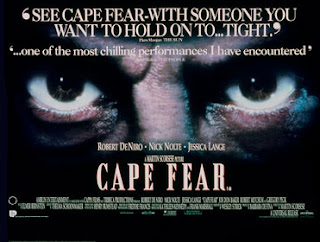
By Kriss Okai-koi













